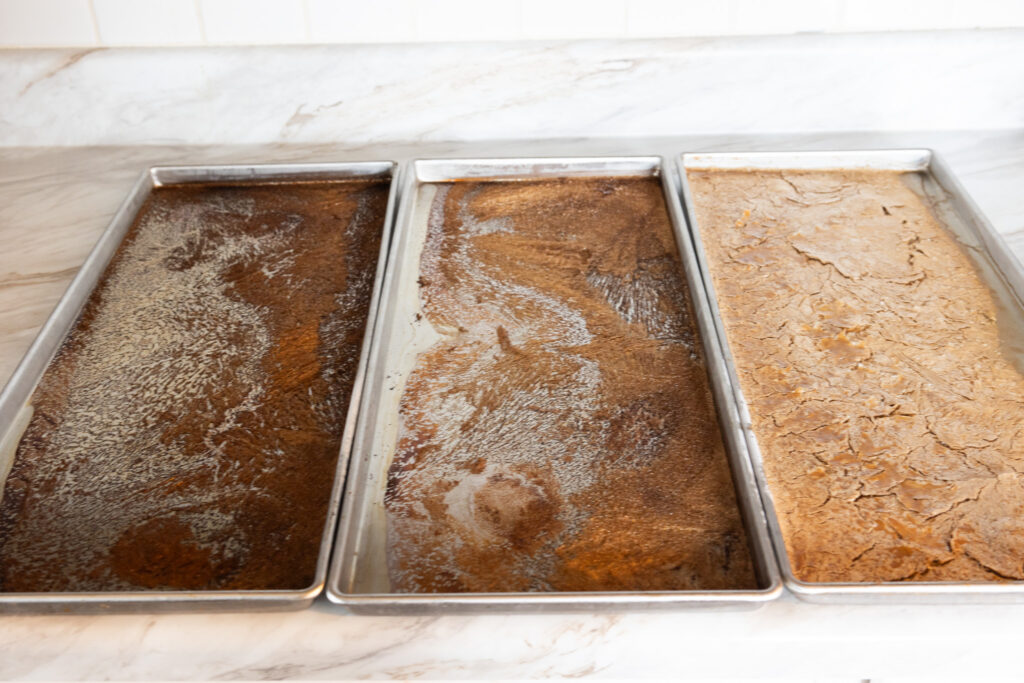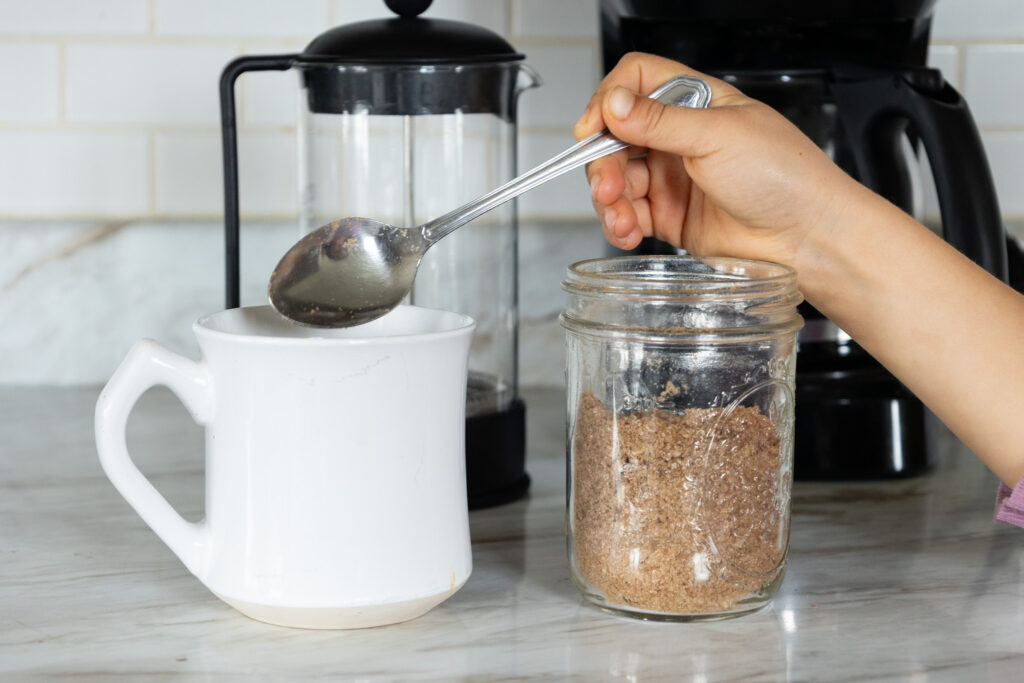Freeze-dried coffee offers the convenience of instant coffee with an improved taste that often mirrors freshly brewed options.

This post contains affiliate links which means I make a small commission at no extra cost to you. See my full disclosure here.
The process involves freezing the coffee extract and then placing it under a vacuum, allowing the ice to vaporize without passing through a liquid phase in a method called sublimation. This technique preserves the coffee’s flavor and aroma compounds, resulting in a product that is easy to prepare by simply adding hot water.

Understanding how freeze-dried coffee is created is essential for appreciating its distinct qualities. Manufacturers first brew coffee conventionally to create an extract. This liquid is then rapidly frozen and subjected to a high vacuum. The sublimation process that follows requires precise temperature and pressure controls to ensure the coffee’s characteristic flavors are retained.
Making freeze-dried coffee at home might not be practical due to the need for specialized equipment. However, knowing the science behind it sheds light on why it’s favored among outdoor enthusiasts, travelers, and those with limited time who don’t want to compromise on the quality of their coffee experience. A deeper appreciation comes with the knowledge of the efforts undertaken by producers to deliver a product that strives to balance convenience and taste.
Basics of Freeze Drying

Freeze drying is a dehydration process that preserves perishable material, making it ideal for creating instant coffee.
What Is Freeze Drying
Freeze drying, also known as lyophilization, involves several steps to dehydrate an item. Initially, the coffee is frozen, and then the pressure is reduced. Following this, a heat source is applied, causing the frozen water in the coffee to sublimate directly from the ice phase to the vapor phase, thereby removing most of the moisture content.
Advantages of Freeze-Dried Coffee
There are several key advantages to freeze-dried coffee:
- Long Shelf Life: The removal of moisture ensures that freeze-dried coffee can be stored for extended periods without spoilage.
- Flavor Preservation: It maintains the original taste and aroma of the coffee because the process occurs at low temperatures, which limits the degradation of important flavor compounds.
- Convenience: It’s easy to prepare by simply adding hot water, making it perfect for instant coffee solutions.
The Freeze Drying Process

The freeze drying process transforms liquid coffee into stable, lightweight granules through low temperature dehydration. Each step is crucial for the quality of the final product.
Pre-Freezing the Coffee
Pre-freezing prepares the coffee extract for the primary drying phase. The liquid coffee is poured into trays and frozen at temperatures below -40°C. This step solidifies the coffee, forming a stable structure that optimizes the sublimation process during drying.
Primary Drying
During primary drying, the coffee is subjected to a vacuum while adding a small amount of heat. The ice within the pre-frozen coffee sublimates, turning directly from solid to vapor. This phase removes about 95% of the water content and is performed at pressures ranging from 0.020 to 0.040 mBar.
Secondary Drying
The final step is secondary drying, which aims to eliminate any remaining moisture. Temperatures are raised higher than in primary drying, often between 30°C and 60°C, and the vacuum is maintained or increased. This stage can last several hours and ensures the residual moisture content is reduced to approximately 2% or less.
Equipment and Materials

In crafting freeze-dried coffee, specific equipment is essential, and the quality of coffee selected impacts the final product’s flavor.
Required Freeze Drying Equipment
To begin freeze-drying coffee, one must have access to a freeze dryer, which is the primary piece of machinery. A vacuum pump attached to the freeze dryer is crucial for creating the necessary low-pressure environment. Additionally, trays that fit inside the freeze dryer are required to lay out the coffee extract for the freeze-drying process. Essential for monitoring, a temperature gauge and humidity meter provide control over the drying conditions.
- Freeze Dryer: The central piece of equipment.
- Vacuum Pump: Integral for establishing a vacuum.
- Trays: Needed to hold the coffee extract during drying.
- Temperature Gauge: For monitoring the freeze dryer’s internal temperature.
- Humidity Meter: To track moisture levels during the drying process.
Selecting the Right Coffee
The choice of coffee is paramount, as it dictates the taste and aroma of the freeze-dried end product. High-quality, arabica beans are typically preferred due to their smoother and more nuanced flavors compared to the more robust robusta beans. The coffee should be brewed and concentrated before freeze drying, and its origin, roast profile, and grind size can all influence the extract’s flavor intensity and subtleties.
- Arabica Beans: Often chosen for premium taste.
- Robusta Beans: An alternative with a stronger, more bitter flavor.
- Choosing Details:
- Origin: Impacts coffee’s unique flavor profile.
- Roast Profile: Affects the intensity and depth of flavor.
- Grind Size: Influences the concentration of the extract.
Preparation of Coffee for Freeze Drying

The process of freeze drying coffee begins with selecting high-quality beans and brewing them properly, followed by precise preparation for freezing.
Proper Brewing Techniques
Before coffee can undergo freeze drying, it must first be brewed to perfection. The choice of coffee beans is crucial; beans should be freshly roasted and ground to a fine consistency. Brewing temperature plays a critical role and should be maintained at about 90°C to 96°C (195°F to 205°F). The coffee-to-water ratio is best kept at 1:17, meaning for every gram of coffee, 17 grams of water is used. Brewing time should be monitored to avoid over or under-extraction.
- Bean Selection: Choose freshly roasted, high-quality beans.
- Grinding: Grind beans to a fine consistency.
- Water Temperature: Maintain 90°C to 96°C.
- Coffee-to-Water Ratio: Use a 1:17 ratio.
- Brew Time: Monitor to achieve optimal extraction.
Preparing for the Freezing Phase
Once the coffee is brewed, it needs to be prepared for freezing. The coffee liquid should be rapidly cooled to prevent deterioration. This is best achieved by placing the container of brewed coffee into an ice water bath. After cooling, pour the coffee into a thin layer on a pre-chilled tray to ensure an even freeze. The uniformity of the layer is key; it should be no more than one inch thick to facilitate consistent freeze drying.
- Rapid Cooling: Chill brewed coffee quickly using an ice water bath.
- Pre-chilled Trays: Pour coffee onto pre-chilled trays.
- Uniform Thickness: Spread into an even layer, ideally one inch thick.
The Packaging Process

Proper packaging is crucial for preserving the quality and flavor of freeze-dried coffee. It involves selecting the right containers and creating a barrier to maintain freshness.
Choosing Suitable Containers
When selecting containers for freeze-dried coffee, manufacturers must ensure that the material is impermeable to air and moisture.
Glass jars and metallic cans with airtight seals are commonly used due to their excellent barrier properties. For more flexible options, mylar bags with oxygen absorbers offer lightweight yet effective protection.
- Glass jars: Ideal for small-batch or premium coffee.
- Metallic cans: Durable for transportation and long-term storage.
- Mylar bags: Cost-effective and suitable for various sizes.
Preserving Freshness
Maintaining the coffee’s freshness after freeze-drying necessitates an oxygen-free environment to prevent oxidation. Manufacturers often use nitrogen flushing, a process where nitrogen gas is used to displace oxygen in the packaging before sealing. Additionally, the inclusion of oxygen absorbers within the packaging can further ensure the extension of the product’s shelf life.
- Nitrogen flushing: Displaces oxygen, extending freshness.
- Oxygen absorbers: Remove any residual oxygen, preventing degradation.
Quality Control

In the production of freeze-dried coffee, consistent quality is paramount. Quality control ensures that each batch meets established standards for flavor and moisture content.
Taste Testing
Sample Selection: A random sample of freeze-dried coffee from each batch is selected for taste testing.
Testing Protocol: Trained professionals assess the coffee’s aroma, flavor, acidity, body, and aftertaste. They use a standardized scoring system to maintain objectivity.
- Aroma: Check for any off-odors or lack of coffee fragrance.
- Flavor: Evaluate for desired coffee characteristics and absence of undesirable notes.
- Acidity: Confirm the acidity is within the preferred range, neither too flat nor overly sharp.
- Body: Verify the coffee’s mouthfeel aligns with expected viscosity.
- Aftertaste: Ensure the finish is pleasant and lingering appropriately.
Moisture Analysis
Equipment Usage: Moisture meters are deployed to measure the water content of freeze-dried coffee samples.
Standards Compliance: Results must comply with industry standards, typically below 5% moisture to guarantee shelf-stability.
- Test Frequency: Conduct moisture analysis for each production lot.
- Documentation: Record all results in a quality control log for traceability.
Corrective Actions: If moisture content exceeds specifications, the batch is reprocessed or discarded.
Storage and Shelf Life

Proper storage is crucial to maintaining the quality and extending the shelf life of freeze-dried coffee. Below, guidelines are provided to ensure optimal conditions.
Container:
- Use an airtight container to prevent moisture absorption.
- If available, opaque containers are preferred to minimize light exposure.
- Mylar bags are ideal for maintaining freshness
Environment:
- Store in a cool, dry place.
- Avoid areas with fluctuating temperatures such as near ovens or windows.
Shelf Life:
- Unopened, freeze-dried coffee can last up to 25 years.
- Once opened, ideally use within 2 to 3 weeks for best flavor.
After Opening:
- Seal tightly after each use.
- Consider transferring to a smaller container to minimize air contact if original package is large.
Note: Do not store in the refrigerator or freezer, as this can introduce moisture each time it is opened.
Temperature and Humidity:
| Ideal Temperature | Ideal Humidity Level |
|---|---|
| Below 75°F (24°C) | Less than 35% |
Adhering to these storage guidelines ensures the consumer can enjoy the robust flavor and aroma that they expect from high-quality freeze-dried coffee.
Related Articles:
How to Have Long Term Food Storage
Harvest Right Freeze Dryer Review (Extremely Honest)
How to Make Freeze Dried Strawberries
Pin it for Later!


Leave a Reply